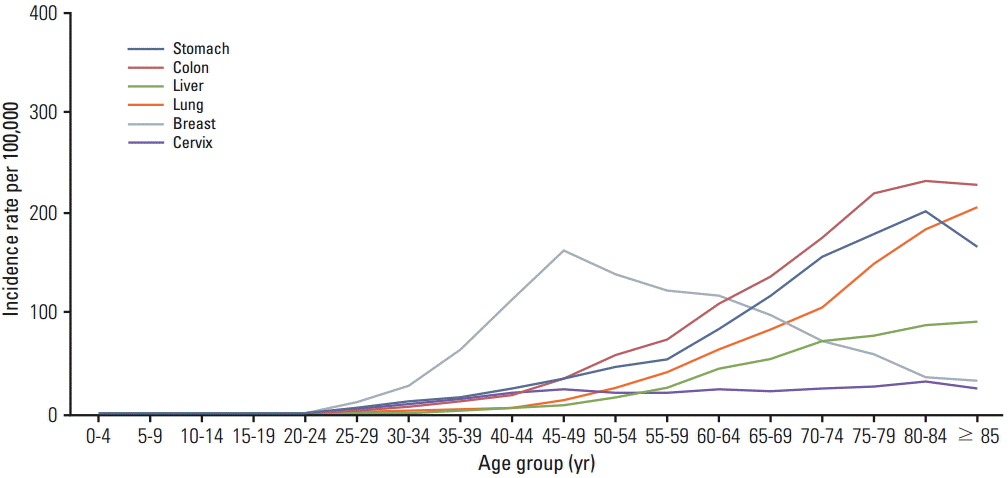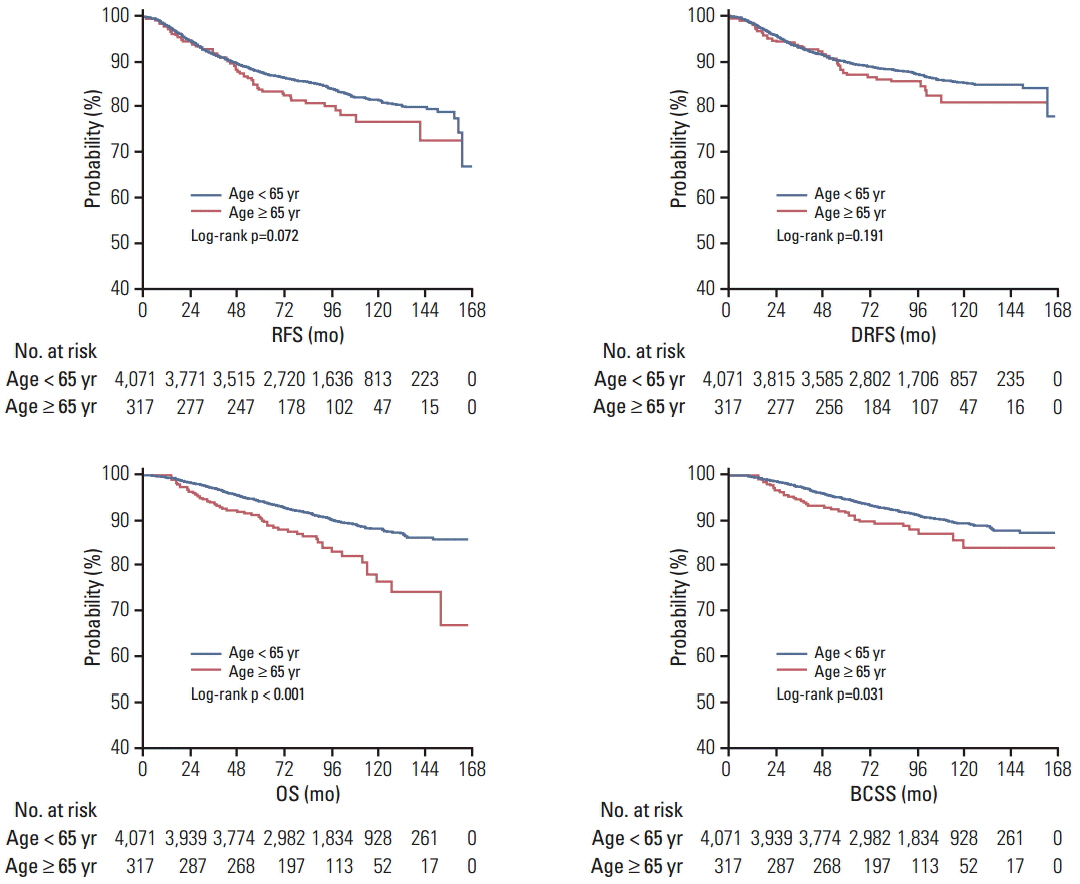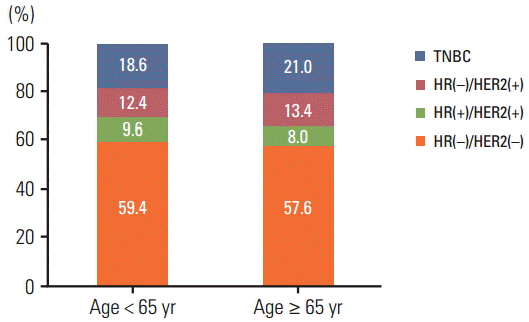Cancer Res Treat.
2016 Oct;48(4):1382-1388. 10.4143/crt.2015.423.
Clinicopathologic Features and Long-Term Outcomes of Elderly Breast Cancer Patients: Experiences at a Single Institution in Korea
- Affiliations
-
- 1Division of Hematology-Oncology, Department of Internal Medicine, Samsung Medical Center, Sungkyunkwan University School of Medicine, Seoul, Korea. yhparkhmo@skku.edu
- 2Department of Surgery, Samsung Medical Center, Sungkyunkwan University School of Medicine, Seoul, Korea.
- KMID: 2356240
- DOI: http://doi.org/10.4143/crt.2015.423
Abstract
- PURPOSE
The purpose of this study was to assess the tumor characteristics and long-term clinical outcomes of adjuvant treatments after surgery with a curative aim for patients with breast cancer who are 65 years and older.
MATERIALS AND METHODS
Patients with breast cancer who underwent curative surgery from 2000 to 2009 were analyzed (n=4,388). Tumor characteristics and survival outcome were compared by dividing the patients into two age groups (< 65 and ≥ 65 years old). The Kaplan-Meier method was used for comparison of survival rates by log-rank test, and a Cox regression model was used to examine the effect of variables.
RESULTS
Among 4,388 patients with invasive breast cancer, 317 patients (7.2%) were 65 years or older and the median age of all patients was 47 years (range, 18 to 91 years). Tumor characteristics were similar between the two age groups, but the older patients were treated less often with adjuvant treatments. During a median follow-up period of 122 months, recurrence-free survival (RFS) was equivalent for patients 65 years and older compared to younger patients, but significantly worse in overall survival (OS) and breast cancer-specific survival (BCSS) (5-year OS, 94.3% vs. 90.5%; p < 0.001 and 5-year BCSS, 94.7% vs. 91.8%; p=0.031). In the multivariate model, age ≥ 65 years old was identified as an independent risk factor for OS and RFS.
CONCLUSION
Elderly breast cancer appeared to have worse outcomes with very low prevalence in Korea, despite similar tumor characteristics. More active adjuvant therapies would have a role for aggressive subtypes for fit, elderly patients.
MeSH Terms
Figure
Reference
-
References
1. Yancik R. Cancer burden in the aged: an epidemiologic and demographic overview. Cancer. 1997; 80:1273–83.2. Korea National Statistical Office. 2015 Statistical report on the aged [Internet]. Daejeon: Korea Statistical Information System (KOSIS);c2015 [cited 2015 Oct 1]. Available from: http://kosis.kr/ups/ups_01List.jsp.3. Ferlay J, Shin HR, Bray F, Forman D, Mathers C, Parkin DM. Estimates of worldwide burden of cancer in 2008: GLOBOCAN 2008. Int J Cancer. 2010; 127:2893–917.
Article4. Han W, Kim SW, Park IA, Kang D, Kim SW, Youn YK, et al. Young age: an independent risk factor for disease-free survival in women with operable breast cancer. BMC Cancer. 2004; 4:82.
Article5. Ko SS; Korean Breast Cancer Society. Chronological changing patterns of clinical characteristics of Korean breast cancer patients during 10 years (1996-2006) using nationwide breast cancer registration on-line program: biannual update. J Surg Oncol. 2008; 98:318–23.
Article6. Leong SP, Shen ZZ, Liu TJ, Agarwal G, Tajima T, Paik NS, et al. Is breast cancer the same disease in Asian and Western countries? World J Surg. 2010; 34:2308–24.
Article7. National Cancer Center. 2012 Report on the statistics for national cancer incidence [Internet]. Goyang: National Cancer Infromation Center;c2015 [cited 2015 Oct 1]. Available from: http://ncc.re.kr/cancerStatsView.ncc?bbsnum=316&searchKey=total&searchValue=&pageNum=1.8. Goodwin JS, Hunt WC, Humble CG, Key CR, Samet JM. Cancer treatment protocols: who gets chosen? Arch Intern Med. 1988; 148:2258–60.
Article9. Yancik R, Wesley MN, Ries LA, Havlik RJ, Edwards BK, Yates JW. Effect of age and comorbidity in postmenopausal breast cancer patients aged 55 years and older. JAMA. 2001; 285:885–92.
Article10. Clark GM. The biology of breast cancer in older women. J Gerontol. 1992; 47 Spec No:19–23.11. Karuturi M, VanderWalde N, Muss H. Approach and management of breast cancer in the elderly. Clin Geriatr Med. 2016; 32:133–53.
Article12. Mislang AR, Biganzoli L. Adjuvant systemic therapy in older breast cancer women: can we optimize the level of care? Cancers (Basel). 2015; 7:1191–214.
Article13. Biganzoli L, Wildiers H, Oakman C, Marotti L, Loibl S, Kunkler I, et al. Management of elderly patients with breast cancer: updated recommendations of the International Society of Geriatric Oncology (SIOG) and European Society of Breast Cancer Specialists (EUSOMA). Lancet Oncol. 2012; 13:e148–60.
Article14. Bouchardy C, Rapiti E, Fioretta G, Laissue P, Neyroud-Caspar I, Schafer P, et al. Undertreatment strongly decreases prognosis of breast cancer in elderly women. J Clin Oncol. 2003; 21:3580–7.
Article15. Tew WP, Muss HB, Kimmick GG, Von Gruenigen VE, Lichtman SM. Breast and ovarian cancer in the older woman. J Clin Oncol. 2014; 32:2553–61.
Article16. Diab SG, Elledge RM, Clark GM. Tumor characteristics and clinical outcome of elderly women with breast cancer. J Natl Cancer Inst. 2000; 92:550–6.
Article17. Lawson JS, Field AS, Champion S, Tran D, Ishikura H, Trichopoulos D. Low oestrogen receptor alpha expression in normal breast tissue underlies low breast cancer incidence in Japan. Lancet. 1999; 354:1787–8.18. Bouchardy C, Rapiti E, Blagojevic S, Vlastos AT, Vlastos G. Older female cancer patients: importance, causes, and consequences of undertreatment. J Clin Oncol. 2007; 25:1858–69.
Article19. Dore M, Cutuli B, Cellier P, Campion L, Le Blanc M. Hypofractionated irradiation in elderly patients with breast cancer after breast conserving surgery and mastectomy: analysis of 205 cases. Radiat Oncol. 2015; 10:161.
Article20. Du XL, Zhang Y, Parikh RC, Lairson DR, Cai Y. Comparative effectiveness of chemotherapy regimens in prolonging survival for two large population-based cohorts of elderly adults with breast and colon cancer in 1992-2009. J Am Geriatr Soc. 2015; 63:1570–82.
Article21. Muss HB, Berry DA, Cirrincione CT, Theodoulou M, Mauer AM, Kornblith AB, et al. Adjuvant chemotherapy in older women with early-stage breast cancer. N Engl J Med. 2009; 360:2055–65.
Article22. Klepin H, Mohile S, Hurria A. Geriatric assessment in older patients with breast cancer. J Natl Compr Canc Netw. 2009; 7:226–36.
Article23. Caillet P, Canoui-Poitrine F, Vouriot J, Berle M, Reinald N, Krypciak S, et al. Comprehensive geriatric assessment in the decision-making process in elderly patients with cancer: ELCAPA study. J Clin Oncol. 2011; 29:3636–42.
Article
- Full Text Links
- Actions
-
Cited
- CITED
-
- Close
- Share
- Similar articles
-
- The Short-term Outcome and Safety of Laparoscopic Colorectal Cancer Resection in Very Elderly Patients
- Apocrine Carcinoma of the Breast: Clinicopathologic Analysis of 19 Cases
- Retrospective Cohort Study on the Long-term Oncologic Outcomes of Sentinel Lymph Node Mapping Methods (Dye-Only versus Dye and Radioisotope Mapping) in Early Breast Cancer: A Propensity Score-Matched Analysis
- Three Cases of Elderly Women with Breast Cancer treated with Non-operative Methods
- Experiences of Accessing Medical Services after Diagnosis in Breast Cancer Survivors




